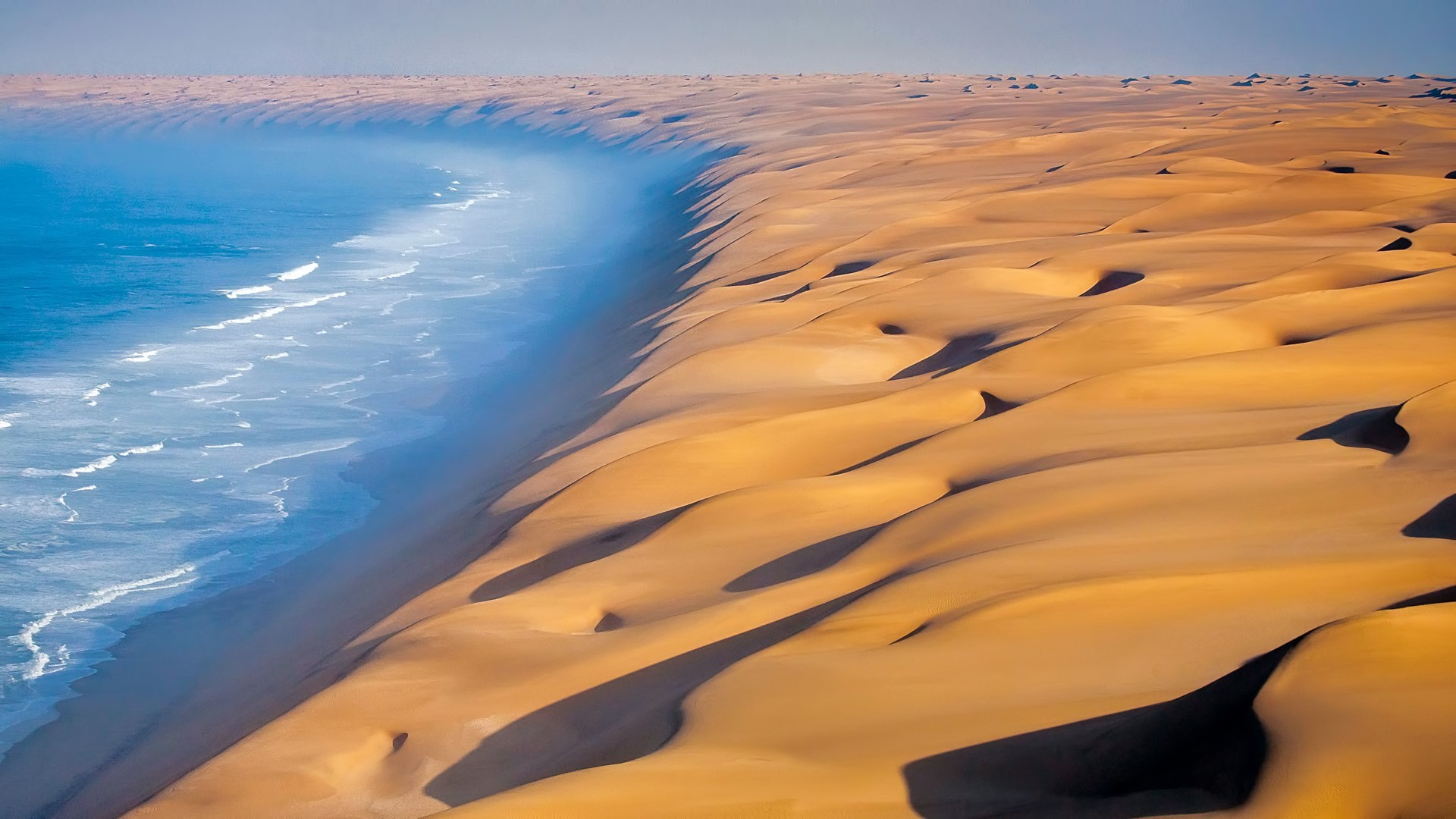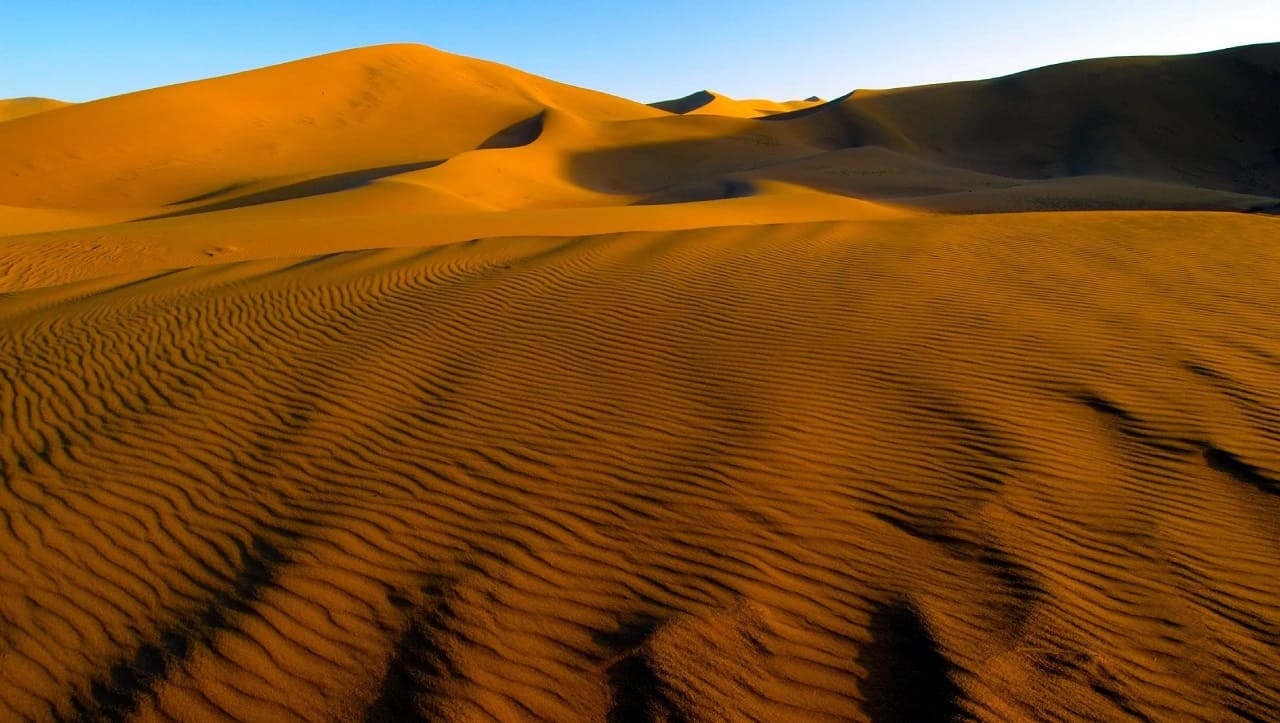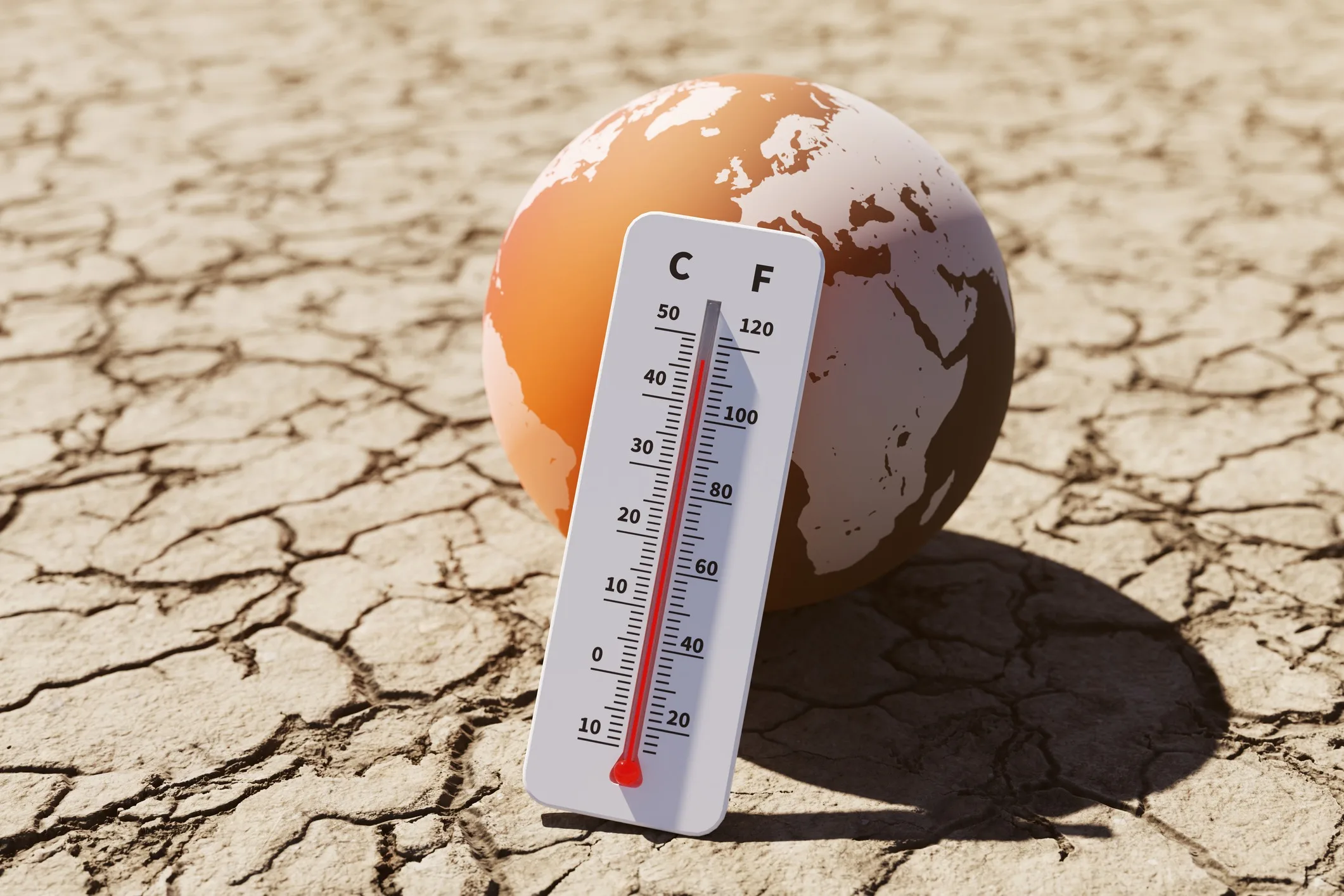Home>Health & Nutrition>Discover Fascinating Facts About Deserts: A Comprehensive Guide


Health & Nutrition
Discover Fascinating Facts About Deserts: A Comprehensive Guide
Published: February 19, 2024
Explore the health and nutrition benefits of deserts with our comprehensive guide. Discover fascinating facts and valuable insights to enhance your well-being.
(Many of the links in this article redirect to a specific reviewed product. Your purchase of these products through affiliate links helps to generate commission for Temperatures.com, at no extra cost. Learn more)
Table of Contents
Introduction
Deserts have long captivated the human imagination with their vast, arid landscapes and extreme climates. These enigmatic regions, characterized by minimal precipitation and sparse vegetation, are often misunderstood and underestimated. However, deserts are not simply barren wastelands; they are complex ecosystems teeming with life and rich in geological and ecological wonders.
The allure of deserts lies in their ability to evoke a sense of both mystery and resilience. From the scorching sands of the Sahara to the icy expanses of Antarctica, deserts exist in various forms across the globe, each with its own distinct features and adaptations. Exploring these diverse landscapes unveils a world of fascinating contrasts, where life thrives against all odds and where the forces of nature sculpt breathtaking vistas.
In this comprehensive guide, we will embark on a captivating journey to unravel the secrets of deserts. We will delve into the formation of deserts, uncover the different types of deserts that exist, and marvel at the unique flora and fauna that have evolved to survive in these harsh environments. Additionally, we will examine the remarkable adaptations of desert animals, explore the impact of human activities on these delicate ecosystems, and celebrate the conservation efforts aimed at preserving these natural wonders.
Join us as we traverse the shifting sands and rugged terrains of deserts, unearthing the hidden treasures and extraordinary resilience that define these remarkable landscapes. Prepare to be enthralled by the captivating world of deserts, where survival is an art, and nature's ingenuity knows no bounds.
The Formation of Deserts
Deserts are not merely the result of a lack of rainfall; their formation is a complex interplay of geographical, climatic, and environmental factors. Understanding the processes that give rise to these unique landscapes is crucial to appreciating their profound natural beauty and ecological significance.
Geological Forces
The formation of deserts is often linked to the presence of mountain ranges. As moist air masses are forced to ascend over these barriers, they cool and release their moisture as precipitation on the windward side. This phenomenon, known as orographic lift, creates lush, fertile regions while simultaneously creating rain shadows on the leeward side. These rain shadows, characterized by dry, arid conditions, are the foundation of many deserts worldwide.
Climate Patterns
Deserts also form in areas where prevailing atmospheric circulation patterns inhibit the influx of moisture. The subtropical high-pressure belts, located around 30 degrees north and south of the equator, are notorious for their dry, descending air masses, which suppress cloud formation and precipitation. Additionally, the presence of cold ocean currents can contribute to the aridity of coastal regions, further shaping the formation of deserts.
Tectonic Activity
Tectonic forces play a pivotal role in desert formation. The shifting of tectonic plates can lead to the creation of vast basins and depressions, where evaporation exceeds precipitation, resulting in the emergence of salt flats and desolate landscapes. Furthermore, tectonic activity can give rise to volcanic activity, which, in turn, can produce barren, ash-covered terrains that mimic the harsh conditions of deserts.
Read more: Saturn’s Temperature: Facts And Information
Human Influence
While natural processes primarily drive desert formation, human activities can exacerbate desertification. Unsustainable land use practices, such as overgrazing, deforestation, and improper irrigation techniques, can accelerate soil erosion and degrade vegetation, leading to the expansion of desert areas. Understanding the intricate interplay of natural and anthropogenic factors is crucial in addressing the challenges posed by desertification and preserving these fragile ecosystems.
In essence, the formation of deserts is a multifaceted process shaped by geological, climatic, and human influences. By unraveling the intricate mechanisms that give rise to these awe-inspiring landscapes, we gain a deeper appreciation for the delicate balance of nature and the resilience of life in the harshest of environments.
Types of Deserts
Deserts are not monolithic entities; they encompass a diverse array of landscapes, each with its own unique characteristics and ecological adaptations. Understanding the different types of deserts sheds light on the remarkable variations in climate, geography, and biodiversity that define these arid regions.
Hot and Dry Deserts
Hot and dry deserts, also known as subtropical deserts, are perhaps the most iconic desert type. Characterized by scorching temperatures and minimal precipitation, these deserts exhibit extreme fluctuations between day and night temperatures. The Sahara Desert in Africa and the Mojave Desert in North America are prime examples of hot and dry deserts, where relentless sun and sparse vegetation dominate the landscape.
Semi-arid Deserts
Semi-arid deserts, often referred to as cold deserts, experience harsh winters and relatively milder summers. These deserts receive slightly more precipitation than their hot and dry counterparts but still exhibit arid conditions. The Gobi Desert in Asia and the Great Basin Desert in the United States exemplify the unique climatic characteristics of semi-arid deserts, where hardy vegetation and adapted wildlife endure the challenging seasonal variations.
Coastal Deserts
Coastal deserts are shaped by the influence of cold ocean currents, which contribute to their arid conditions. These deserts are situated along the western edges of continents, where the cold currents inhibit the formation of clouds and subsequent rainfall. The Atacama Desert in South America and the Namib Desert in Africa are notable coastal deserts, renowned for their otherworldly landscapes and distinct flora and fauna.
Cold Deserts
Cold deserts, also known as polar deserts, are defined by their frigid temperatures and sparse precipitation. These deserts are found in polar regions, such as Antarctica and the Arctic, where the icy terrain and limited vegetation create an environment that is uniquely adapted to extreme cold. Despite the harsh conditions, cold deserts harbor a surprising diversity of life, including resilient plants and specialized animal species that have evolved to thrive in these unforgiving climates.
Mountain Deserts
Mountain deserts are situated at high elevations, where the rugged terrain and reduced atmospheric pressure contribute to arid conditions. These deserts, such as the Andean Desert in South America and the Tibetan Plateau in Asia, showcase the interplay between altitude and aridity, creating awe-inspiring landscapes and fostering distinct ecological communities adapted to the challenges of high-altitude desert environments.
In essence, the classification of deserts into different types underscores the remarkable diversity and adaptability of these ecosystems. Each type of desert presents a unique tapestry of geological formations, climatic extremes, and specialized life forms, offering a captivating glimpse into the resilience and ingenuity of nature in the face of adversity.
Unique Flora and Fauna
Deserts are not barren wastelands devoid of life; they are home to a diverse array of flora and fauna that have evolved remarkable adaptations to thrive in the harsh and unforgiving conditions. The unique ecosystems of deserts harbor a wealth of specialized plant species, resilient animals, and fascinating adaptations that showcase the ingenuity of nature in the face of extreme aridity and temperature fluctuations.
Flora of Deserts
The flora of deserts is characterized by a remarkable ability to conserve water and withstand the intense heat and limited nutrients available in these arid environments. Succulent plants, such as cacti and agaves, are iconic desert inhabitants known for their water-storing adaptations, including fleshy stems and specialized root systems. These plants not only survive in arid conditions but also provide essential resources for desert wildlife, serving as food and water sources.
Additionally, desert flora includes drought-resistant shrubs, hardy grasses, and ephemeral wildflowers that bloom in response to sporadic rainfall, painting the desert landscapes with vibrant bursts of color. The unique adaptations of desert plants, such as reduced leaf surfaces to minimize water loss and deep root systems to access underground moisture, exemplify the resilience and resourcefulness of desert flora in the face of adversity.
Fauna of Deserts
The fauna of deserts is equally diverse and resilient, encompassing a myriad of specialized animal species that have evolved remarkable adaptations to survive in arid environments. From the elusive fennec fox of the Sahara Desert to the iconic kangaroo rat of North American deserts, desert animals have developed an array of physiological, behavioral, and anatomical adaptations to thrive in the extreme conditions of their habitats.
Many desert animals are nocturnal, minimizing their exposure to the scorching daytime temperatures, while others have evolved efficient water-conservation mechanisms, such as concentrated urine and the ability to extract moisture from their food. The camouflage and burrowing behaviors of desert reptiles and insects, such as the sidewinder snake and the sand scorpion, further illustrate the remarkable adaptations that enable these creatures to navigate the challenges of desert life.
Furthermore, desert ecosystems are vital habitats for migratory birds, such as the sandhill crane and the greater flamingo, which rely on desert oases and wetlands as crucial stopover points during their long journeys. The interconnected web of desert flora and fauna underscores the intricate balance and interdependence of these ecosystems, where every species plays a vital role in the survival of the desert community.
In essence, the unique flora and fauna of deserts offer a captivating glimpse into the resilience and adaptability of life in the face of extreme environmental conditions. The intricate web of interactions and adaptations within desert ecosystems serves as a testament to the remarkable ingenuity of nature and the awe-inspiring diversity of life that thrives in the world's most challenging environments.
Adaptations of Desert Animals
Desert animals have evolved an impressive array of adaptations to thrive in the harsh and unforgiving environments of arid landscapes. These remarkable adaptations encompass a wide spectrum of physiological, behavioral, and anatomical traits that enable desert animals to overcome the challenges of extreme heat, limited water sources, and scarce food supplies.
One of the most striking adaptations of desert animals is their ability to conserve water. Many desert-dwelling species have developed specialized physiological mechanisms to minimize water loss and maximize water retention. For instance, the kangaroo rat, a nocturnal rodent found in North American deserts, possesses highly concentrated urine and efficient kidneys that enable it to extract the maximum amount of water from its food, allowing it to thrive in water-scarce habitats. Similarly, the fennec fox, a small fox species native to the Sahara Desert, has adapted to obtain most of its water needs from the food it consumes, reducing its reliance on external water sources.
In addition to water conservation, desert animals have evolved behavioral adaptations to cope with the extreme temperatures of their habitats. Many desert species are nocturnal, avoiding the scorching heat of the day and capitalizing on the cooler nighttime temperatures to forage for food and engage in essential activities. Nocturnal behavior allows these animals to minimize water loss through evaporation and seek refuge from the intense daytime heat, showcasing their remarkable ability to adapt their lifestyles to the challenging desert environment.
Furthermore, the anatomical adaptations of desert animals play a crucial role in their survival. The iconic camels, well-known for their ability to thrive in desert environments, possess specialized physiological features, including efficient water conservation mechanisms and the ability to tolerate high body temperatures, allowing them to endure long periods without water and withstand the blistering heat of the desert sun. Similarly, the sand gazelle, a desert-dwelling antelope species, has evolved elongated legs and a light-colored coat to dissipate heat and navigate the sandy terrain with agility, showcasing the intricate anatomical adaptations that enable desert animals to thrive in their harsh habitats.
The adaptations of desert animals exemplify the remarkable resilience and ingenuity of nature in the face of extreme environmental conditions. From specialized water-conservation mechanisms to behavioral strategies that minimize heat exposure, desert animals have honed their survival tactics over millennia, embodying the awe-inspiring diversity and adaptability of life in some of the world's most challenging ecosystems.
Human Impact on Deserts
Human activities have significantly impacted desert ecosystems, leading to profound environmental changes and challenges for the delicate balance of these arid landscapes. The expansion of agriculture, urbanization, and industrial development has exerted pressure on desert regions, resulting in widespread consequences for the flora, fauna, and overall ecological integrity of these unique environments.
One of the most significant human impacts on deserts is the process of desertification, which refers to the degradation of arid and semi-arid lands due to various factors, including unsustainable land use practices, deforestation, overgrazing, and improper irrigation techniques. These activities contribute to soil erosion, loss of vegetation cover, and the depletion of water resources, leading to the expansion of desert areas and the degradation of once-viable habitats for desert flora and fauna.
Furthermore, the extraction of natural resources, such as oil and minerals, has led to habitat destruction and fragmentation in desert regions. Mining activities and the construction of infrastructure, including roads and pipelines, have disrupted the natural landscapes and fragmented wildlife habitats, posing significant challenges for the survival of desert species and the maintenance of ecological connectivity.
The introduction of invasive species and the overexploitation of natural resources have also had detrimental effects on desert ecosystems. Invasive plant species can outcompete native flora, leading to the degradation of natural habitats and the loss of biodiversity. Additionally, overgrazing by livestock and unsustainable hunting practices have further exacerbated the pressures on desert wildlife, leading to population declines and ecological imbalances.
Moreover, climate change poses a significant threat to desert ecosystems, with rising temperatures and altered precipitation patterns impacting the delicate balance of these arid landscapes. The intensification of droughts and the increased frequency of extreme weather events have further compounded the challenges faced by desert flora and fauna, placing additional stress on already vulnerable ecosystems.
Addressing the human impact on deserts requires concerted efforts to promote sustainable land management practices, conservation initiatives, and the restoration of degraded desert habitats. By implementing measures to mitigate desertification, protect wildlife habitats, and promote sustainable resource use, it is possible to safeguard the ecological integrity of deserts and ensure the continued survival of their unique flora and fauna.
In essence, the human impact on deserts underscores the urgent need for proactive conservation efforts and sustainable management practices to preserve these remarkable ecosystems for future generations. By recognizing the interconnectedness of human activities and desert environments, it is possible to foster a harmonious coexistence that respects the resilience and ecological significance of these awe-inspiring landscapes.
Famous Deserts Around the World
The world is home to a diverse array of deserts, each with its own unique characteristics, geological formations, and ecological wonders. From the iconic Sahara Desert in Africa to the otherworldly landscapes of the Atacama Desert in South America, famous deserts captivate the imagination and offer a glimpse into the awe-inspiring diversity of arid environments across the globe.
Sahara Desert
Spanning across North Africa, the Sahara Desert is the largest hot desert in the world, covering an expansive area that rivals the size of the United States. Its vast sand dunes, rocky plateaus, and ancient oases create a landscape of breathtaking contrasts. The Sahara is renowned for its extreme temperatures, with scorching heat during the day and plummeting temperatures at night. Despite the harsh conditions, the Sahara harbors a wealth of unique flora and fauna, including the iconic date palm trees and the elusive Saharan cheetah.
Atacama Desert
Situated along the western coast of South America, the Atacama Desert is often referred to as the driest desert on Earth. Its surreal lunar-like landscapes, salt flats, and towering volcanoes create an otherworldly ambiance that has captivated explorers and scientists alike. The Atacama is renowned for its extreme aridity and high-altitude desert ecosystems, where resilient species, such as the Andean flamingo and the flowering desert plants, have adapted to thrive in the challenging conditions.
Gobi Desert
Located in northern China and southern Mongolia, the Gobi Desert is a vast expanse of arid terrain characterized by its sweeping sand dunes, rocky outcrops, and dramatic canyons. The Gobi is renowned for its diverse geological formations and unique wildlife, including the elusive Bactrian camel and the endangered Gobi bear. The desert's ever-shifting landscapes and rich cultural heritage have made it a source of fascination for adventurers and researchers seeking to unravel its mysteries.
Namib Desert
The Namib Desert, stretching along the Atlantic coast of Namibia, is celebrated for its towering red sand dunes, rugged coastlines, and ancient desert-adapted flora and fauna. The Namib is home to the iconic Sossusvlei dunes, which rise to staggering heights and create a mesmerizing tapestry of colors as the sun traverses the sky. The desert's unique ecosystems, including the resilient Welwitschia plants and the elusive desert-adapted elephants, showcase the remarkable adaptations of life in one of the world's oldest deserts.
Antarctic Desert
Surprisingly, the largest desert on Earth is not a scorching expanse of sand, but the frozen wilderness of Antarctica. Classified as a polar desert, Antarctica's vast ice sheets and frigid temperatures create an environment that is uniquely adapted to extreme cold. Despite the harsh conditions, the Antarctic Desert supports a diverse array of life, including penguins, seals, and resilient microbial communities that thrive in the icy expanses.
In essence, the famous deserts around the world offer a captivating glimpse into the remarkable diversity and resilience of arid landscapes. From the towering dunes of the Sahara to the frozen expanses of Antarctica, these deserts embody the awe-inspiring adaptability of life in some of the world's most challenging environments.
Desert Conservation Efforts
Desert conservation efforts play a pivotal role in safeguarding the fragile ecosystems of arid landscapes and preserving the unique flora, fauna, and geological wonders that define these remarkable environments. These initiatives encompass a wide range of strategies aimed at mitigating the impacts of human activities, addressing desertification, and promoting sustainable management practices to ensure the long-term viability of desert ecosystems.
One of the key pillars of desert conservation efforts is the promotion of sustainable land management practices. By implementing measures to combat soil erosion, restore degraded habitats, and prevent overgrazing, conservation organizations and local communities work together to preserve the delicate balance of desert ecosystems. Additionally, the establishment of protected areas and wildlife reserves in desert regions serves as a crucial mechanism for safeguarding the habitats of endangered species and preserving the ecological integrity of these unique landscapes.
Furthermore, desert conservation efforts focus on raising awareness and fostering community engagement to instill a sense of stewardship and responsibility for desert environments. Educational programs, outreach initiatives, and collaborative projects with local stakeholders empower communities to actively participate in the conservation and sustainable use of desert resources. By promoting a deeper understanding of the ecological value of deserts and the interconnectedness of human activities with these environments, conservation efforts seek to cultivate a culture of conservation and respect for the resilience of desert ecosystems.
In addition to local and regional conservation initiatives, international collaborations and partnerships play a vital role in advancing desert conservation efforts. By sharing knowledge, resources, and best practices, global conservation organizations and governmental agencies work together to address transboundary conservation challenges and promote the sustainable management of desert resources. These collaborative efforts facilitate the exchange of expertise and the development of innovative conservation strategies that transcend geopolitical boundaries, fostering a unified approach to preserving the world's diverse desert ecosystems.
Moreover, research and monitoring programs are integral components of desert conservation efforts, providing essential data and insights to guide conservation interventions and track the status of desert ecosystems. Through scientific research, ecological surveys, and monitoring initiatives, conservationists gain valuable information about the dynamics of desert environments, the impacts of climate change, and the responses of flora and fauna to conservation measures. This knowledge forms the foundation for evidence-based conservation strategies and adaptive management approaches that are essential for the long-term sustainability of desert ecosystems.
In essence, desert conservation efforts are essential for protecting the ecological richness and cultural heritage of deserts, promoting sustainable development, and ensuring the resilience of these extraordinary landscapes for future generations. By embracing a holistic approach that integrates scientific research, community engagement, and international collaboration, conservationists and stakeholders strive to uphold the intrinsic value of deserts and nurture a harmonious coexistence between humanity and the natural world.
Conclusion
In conclusion, deserts stand as captivating testaments to the resilience of life in the face of extreme environmental conditions. From the towering dunes of the Sahara to the frozen expanses of Antarctica, these arid landscapes harbor a wealth of geological, ecological, and cultural wonders that captivate the human imagination. The formation of deserts, shaped by geological forces, climate patterns, and tectonic activity, underscores the intricate interplay of natural processes that give rise to these awe-inspiring environments. However, human activities have significantly impacted desert ecosystems, leading to challenges such as desertification, habitat destruction, and the introduction of invasive species.
Despite these challenges, desert conservation efforts play a pivotal role in safeguarding the fragile ecosystems of arid landscapes and preserving the unique flora, fauna, and geological wonders that define these remarkable environments. By promoting sustainable land management practices, raising awareness, fostering community engagement, and advancing international collaborations, conservationists and stakeholders strive to uphold the intrinsic value of deserts and nurture a harmonious coexistence between humanity and the natural world.
The famous deserts around the world offer a captivating glimpse into the remarkable diversity and resilience of arid landscapes. These deserts embody the awe-inspiring adaptability of life in some of the world's most challenging environments. The unique flora and fauna of deserts offer a captivating glimpse into the resilience and adaptability of life in the face of extreme environmental conditions. The intricate web of interactions and adaptations within desert ecosystems serves as a testament to the remarkable ingenuity of nature and the awe-inspiring diversity of life that thrives in the world's most challenging environments.
In essence, deserts are not simply barren wastelands; they are complex ecosystems teeming with life and rich in geological and ecological wonders. By unraveling the secrets of deserts, we gain a deeper appreciation for the delicate balance of nature and the resilience of life in the harshest of environments. The captivating world of deserts, where survival is an art, and nature's ingenuity knows no bounds, continues to inspire awe and reverence, inviting us to cherish and protect these extraordinary landscapes for generations to come.










